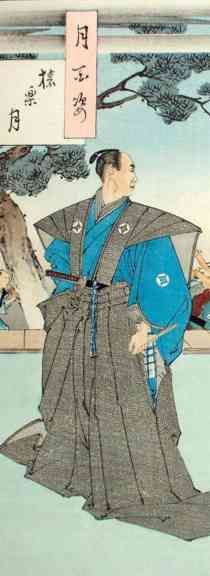
TAISO YOSHITOSHI
(1839-1892)
Taiso Yoshitoshi was born in the city of Edo (now
Tokyo) just before Japan’s violent transformation from a medieval to a
modern society. In the mid
19th century pressures from the United States and Europe
brought an end to Japan’s two hundred years of self-imposed isolation.
In 1868 a pivotal period began known as the Meiji Restoration. It
was marked by the return of Imperial power, heightened militarism, a new
constitution and industrial advancement, as well as social and political
reform. In the midst of shifting values, woodblock print artists like
Yoshitoshi struggled to create images that would satisfy the public’s
changing tastes.
During the Edo period (1600-1868) woodblock prints,
or Ukiyo-e (literally “pictures of the floating world”), became one
of the most popular and inexpensive visual art forms in Japan. Published in the cities, visitors bought them as souvenirs
and gifts from markets and street peddlers and returned with them to
remote villages. From the
time the first monochrome prints were published in the 1600s, Ukiyo-e
represented a unique collaboration between the publisher, the artists
and the public. The rising or diminishing interests of the urban
merchant class largely dictated the choice of subject matter in
woodblock prints.
Yoshitoshi’s confrontation with the savagery and violence of his times, especially early on in his career, was exorcised through a prolific and bloody series of prints depicting battling warriors, demons and murderers. Later in his career, however, Yoshitoshi’s work took on a distinctive stylistic change. By the 1880s, he was experimenting freely with western concepts of space, perspective and dissonant color combinations. His treatment of movement and facial features reflected a more studied and quiet observation of the human form and emotions. While continuing to choose native themes for his prints, Yoshitoshi’s approach to creating individualized portraits of townspeople, farmers, courtesans and warriors was innovative and groundbreaking. However, by the end of the Meiji Period (1868-1912), the increasing popularity of photography and lithography nearly eclipsed the public’s interest in woodblock prints. Yoshitoshi stood alone as the last great master of Ukiyo-e.